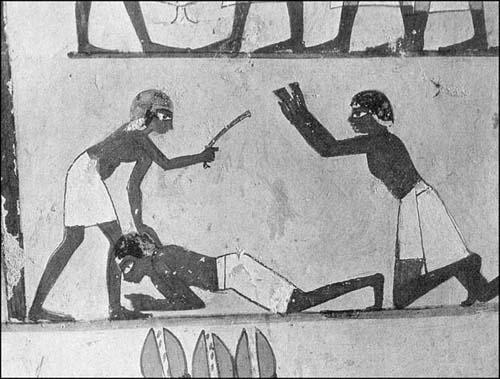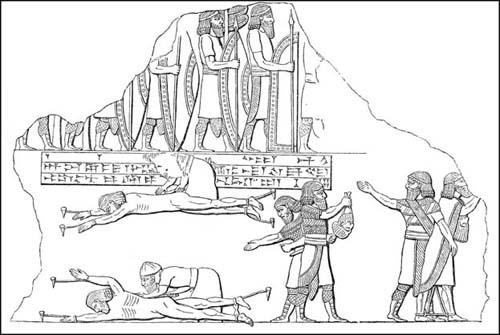The Big Book of Pain: Torture & Punishment Through History (6 page)
Read The Big Book of Pain: Torture & Punishment Through History Online
Authors: Daniel Diehl


The public execution of the Duke of Monmouth in 1685. This was a ghastly spectacle in which the headsman (Jack Ketch) did a very poor job. According to an eyewitness, ‘the butcherly dog did so barbarously act his part that he could not, at five strokes [of the axe] sever the head from the body.’ Finally, Ketch used his belt knife to sever the Duke’s head from his body.
Section II



TORTURE IN THE ANCIENT AND CLASSICAL WORLD
I
n the preceding section we saw that torture can be a common by-product of weak, frightened, paranoid regimes. It would be logical then, to assume that early, primitive cultures would be more prone to the use of torture than more modern, sociologically advanced cultures. But this is simply not the case. While no one can say with certainty which society invented the concept of torture, we can examine those cultures which first kept judicial records and compare the ways in which they dealt with malefactors, transgressors, and enemies.
Most early record-keeping societies – primarily those around the eastern rim of the Mediterranean Sea and in the Tigris and Euphrates basin – shared certain standards as to which crimes were worthy of extreme physical punishment. Patricide (the killing of one’s father), adultery and the dishonour of being taken as a prisoner of war were all considered unforgivable and worthy of severe punishment. Beyond these few common factors, how these societies dealt with other crimes seems to have depended on the particular culture.
Egypt under the Pharaohs was, by and large, a pretty enlightened place. Neither did the Egyptians impose unconscionable punishments on those convicted of crimes. Capital crimes, such as murder, were generally dealt with by hanging. One of the few exceptions to this rule came into play when a parent was convicted of having murdered a child. In this case, the parent was condemned to have the body of their dead child tied around their neck and left there until it decomposed: nasty and unhygienic, no doubt, but hardly excessive considering the crime. Another exception to hanging was when the murder victim was the killer’s father. Those convicted of patricide were subjected to creatively slow and painful ends, including having the flesh whipped from their body with bundles of reeds, being thrown into thorns and rolled back and forth until they were nearly flayed and then being tossed, still living, into a roaring fire. Lesser crimes were accompanied by lesser punishments.
For most non-capital crimes, both civil and criminal, the standard punishment was a public whipping. Curiously, the manner of the whipping differed with the sex of the offender. Women were whipped while in a kneeling position, but men were laid on the ground, face down, in a spread-eagle posture. In both cases the condemned’s garment was stripped from their back before punishment commenced. Logically, the severity of the whipping increased with the severity of the crime. When a man was convicted of having committed adultery with a slave (who was recognised as having no way to protect themselves from such advances) he could be sentenced to as many as 1,000 lashes. Now either this number was not meant to be taken literally, or the whipping was administered with something less than a bundle of sharp reeds or a heavy whip, as such devices would have literally torn the corpse to pieces to no possible end beyond exhausting the torture master. Curiously, when a woman was convicted of adultery she was not executed. Instead, her nose was cut off. Such a punishment would not have prevented her from bearing children, but would undoubtedly have made her less than attractive to future lovers. Physical mutilation was not unique to female adulterers and a number of other crimes carried various forms of mutilation as their punishment. Interestingly, when a person was found to have falsely accused another of any type of crime they were sentenced to the same punishment that their intended victim had, or would have, received. One can reasonably assume that perjury in Pharonic courts was a fairly rare occurrence.

This image depicts the flogging of Egyptian prisoners of war or criminals. Whether the figure on the right is pleading for clemency or is participating in the flogging is uncertain.

This image shows two prisoners of war being flayed alive by the Assyrians while staked out on the ground and a third has been decapitated. This sort of image was important propaganda for its time. It showed the harsh and severe consequences for opposing Assyrian might and served as a warning to neighbouring kingdoms.
The Egyptians were a proud people, and one of the greatest humiliations they could experience was being taken prisoner in battle. Death was preferable to such dishonour. Consequently, when Egyptian armies captured enemy soldiers, their treatment of the vanquished was unpleasant at best. When being marched to captivity, prisoners were bound neck-to-neck, by a series of nooses, kept tight enough to be galling, but not tight enough to cause strangulation. To make the prisoners still more uncomfortable, their elbows were bound tightly together behind their backs. Sometimes, if Pharaoh’s army had had a particularly hard time of it, the prisoners’ agony was intensified by having a cord run from their bound wrists, up their back and around their already bound neck. The more the victim struggled to ease the pain in his elbows and wrists, the more likely he was to strangle himself. Those prisoners who survived the long march back to captivity were generally sold as slaves – after having their eyes, or tongues, cut out. The moral is obvious: don’t make war on the Pharaoh.
A slightly later middle-Eastern civilization, from which a scant few judicial records survive, was the city-state of Eshunna, which flourished between 2000 BC and 1720 BC, and was located only about 30 miles (50km) north of present-day Baghdad, Iraq. Eshunna seems to have had a law covering almost every aspect of daily life and its judicial code includes such familiar offences as theft, burglary, kidnapping, murder, bodily injuries, sex crimes and injury purposefully inflicted on animals. For lesser offences, the judges of Eshunna may have been the first to impose fines rather than inflict bodily punishment – at least a fine would have gone further toward real compensation than the small satisfaction of watching a criminal having the hide flogged from his back. Curiously, when crimes were committed at night they inevitably brought a heavier sentence than when committed during daylight hours. When the crime involved stealing another man’s crops, if the act was carried out during the day the sentence was a fine of ten silver shekels, if it took place during the night the sentence was death.
Similarly, there is a problem determining how the Eshunnans dealt with female criminals as opposed to males, because their written language seems not to have been sexually differentiated – he and she appear to be interchangeable. Hence, the law stating: ‘The day a woman will be seized in the lap of a man, [he/she] shall die, [he/she] shall not live’, leaves us in no doubt that adultery was a very serious crime, but uncertain as to which of the offenders was executed. All things considered, it is reasonable to assume that it was the woman who got the short end of the stick.
The problem with assessing institutionalised torture in early societies is that justice, and the punishment accompanying conviction, were random things, handed out at the whim of a local judge or tribunal. One of the earliest known attempts to codify laws and specify particular punishments for particular crimes came about in Babylon toward the end of the reign of King Hammurabi (reigned 1792–1759 BC). To make his 282 laws, and their associated punishments, understandable by all, Hammurabi had them carved on a 6ft-tall (2m) stone column, copies of which were erected in major cities throughout the empire. While many of the punishments might seem barbaric by modern standards, personal vendettas were outlawed as was the mistreatment of both slaves and women. In many cases, punishments were in the ‘eye for an eye’ tradition known as the
talio
; if a person broke another person’s bones, they were to have the same bones broken or if he purposefully put out another man’s eye, his own eye would be put out. Of particular interest is a law stating that if a physician killed, or maimed, a patient during an operation the doctor would have his hands cut off – obviously preventing such malpractice in the future. Worthy of note in Hammurabi’s code were specific rights given to women, such as no-fault divorces and protection from rape; the punishment for sexual assault being castration for the guilty party. If a man accused his wife of adultery he was required to provide absolute proof of her guilt before casting her off, but if she were found guilty she was to be thrown into the Euphrates River. Should the gods deem her innocent, she would safely find her way to the opposite bank; if guilty she would undoubtedly drown. This watery trial by ordeal would find an echo millennia later in the persecution of women accused of witchcraft.
